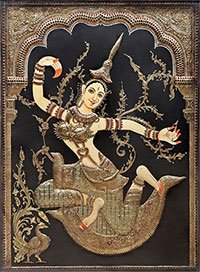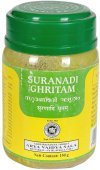Cangeri, Cāṅgerī, Camgeri, Caṃgerī: 12 definitions
Introduction:
Cangeri means something in Hinduism, Sanskrit, biology. If you want to know the exact meaning, history, etymology or English translation of this term then check out the descriptions on this page. Add your comment or reference to a book if you want to contribute to this summary article.
Alternative spellings of this word include Changeri.
In Hinduism
Ayurveda (science of life)
Cikitsa (natural therapy and treatment for medical conditions)
Source: Ancient Science of Life: Botanical identification of plants described in Mādhava CikitsāCāṅgerī (चाङ्गेरी) refers to the medicinal plant Oxalis corniculata L., and is used in the treatment of atisāra (diarrhoea), according to the 7th century Mādhavacikitsā chapter 2. Atisāra refers to a condition where there are three or more loose or liquid stools (bowel movements) per day or more stool than normal. The second chapter of the Mādhavacikitsā explains several preparations [including Cāṅgerī] through 60 Sanskrit verses about treating this problem.
Nighantu (Synonyms and Characteristics of Drugs and technical terms)
Source: WorldCat: Rāj nighaṇṭuCāṅgerī (चाङ्गेरी) (in both Sanskrit and Hindi) is another name for Kṣudrāmlikā, a medicinal plant identified with Oxalis corniculata Linn. or “creeping woodsorrel” from the Oxalidaceae or “wood sorrel” family of flowering plants, according to verse 5.100-102 of the 13th-century Raj Nighantu or Rājanighaṇṭu. The fifth chapter (parpaṭādi-varga) of this book enumerates sixty varieties of smaller plants (kṣudra-kṣupa). Together with the names Cāṅgerī and Kṣudrāmlikā, there are a total of fifteen Sanskrit synonyms identified for this plant.
Unclassified Ayurveda definitions
Source: Wisdom Library: Āyurveda and botanyCāṅgerī (चाङ्गेरी) is a Sanskrit word referring to Oxalis corniculata (creeping woodsorrel), from the Oxalidaceae family. Certain plant parts of Cāṅgerī are eaten as a vegetable (śāka), according to Caraka in his Carakasaṃhitā sūtrasthāna (chapter 27), a classical Ayurvedic work. The plant is therefore part of the Śākavarga group of medicinal plants, referring to the “group of vegetables/pot-herbs”. Caraka defined such groups (vargas) based on the dietic value of the plant. The fruit is a narrow, cylindrical capsule, 1 to 2 cm long and noteworthy for its explosive discharge of the contained (1 mm long) seeds.

Āyurveda (आयुर्वेद, ayurveda) is a branch of Indian science dealing with medicine, herbalism, taxology, anatomy, surgery, alchemy and related topics. Traditional practice of Āyurveda in ancient India dates back to at least the first millenium BC. Literature is commonly written in Sanskrit using various poetic metres.
Sports, Arts and Entertainment (wordly enjoyments)
Source: archive.org: Syainika Sastra of Rudradeva with English Translation (art)Cāṅgerī (चाङ्गेरी) refers to “Oxalis monadelpha” (which used in the treatment of Hawks), according to the Śyainika-śāstra: a Sanskrit treatise dealing with the divisions and benefits of Hunting and Hawking, written by Rājā Rudradeva (or Candradeva) in possibly the 13th century.—Accordingly, [while discussing the treatment of hawks]: “If a white spot forms on the eyes owing to heat, smoke or some kind of hurt, then the eyes are to be filled with the fine powder of the root of Oxalis monadelpha [e.g., (cāṅgerī-mūlacūrṇa)]. A hawk gets rid of this disease in eighteen days. [...]”.

This section covers the skills and profiencies of the Kalas (“performing arts”) and Shastras (“sciences”) involving ancient Indian traditions of sports, games, arts, entertainment, love-making and other means of wordly enjoyments. Traditionally these topics were dealt with in Sanskrit treatises explaing the philosophy and the justification of enjoying the pleasures of the senses.
Biology (plants and animals)
Source: Google Books: CRC World Dictionary (Regional names)Cangeri in India is the name of a plant defined with Oxalis corniculata in various botanical sources. This page contains potential references in Ayurveda, modern medicine, and other folk traditions or local practices It has the synonym Acetosella villosa Kuntze (among others).
Example references for further research on medicinal uses or toxicity (see latin names for full list):
· Notizblatt des Botanischen Gartens und Museums zu Berlin-Dahlem (1919)
· Taxon (1982)
· Oxalis (1781)
· Cell and Chromosome Research (1988)
· Tropical Plant Science Research. New Delhi (1983)
· Bot. Journal of the Linnean Society (1989)
If you are looking for specific details regarding Cangeri, for example chemical composition, pregnancy safety, side effects, extract dosage, diet and recipes, health benefits, have a look at these references.

This sections includes definitions from the five kingdoms of living things: Animals, Plants, Fungi, Protists and Monera. It will include both the official binomial nomenclature (scientific names usually in Latin) as well as regional spellings and variants.
Languages of India and abroad
Sanskrit dictionary
Source: Cologne Digital Sanskrit Dictionaries: Shabda-Sagara Sanskrit-English DictionaryCāṅgerī (चाङ्गेरी).—f. (-rī) Wood sorrel, (Oxalis monadelpha, Rox.) E. cāṅga as above, and ir to send or cause, affixes aṇ and ṅīṣ.
Source: Cologne Digital Sanskrit Dictionaries: Monier-Williams Sanskrit-English Dictionary1) Caṅgerī (चङ्गेरी):—[from caṅgerika] f. idem, [iv, 12; v, 16.]
2) Cāṅgerī (चाङ्गेरी):—[from cāṅga] f. wood-sorrel, [Harivaṃśa 4652; Suśruta vi.]
Source: Cologne Digital Sanskrit Dictionaries: Yates Sanskrit-English DictionaryCāṅgerī (चाङ्गेरी):—(rī) 3. f. Wood-sorrel.
[Sanskrit to German]
Sanskrit, also spelled संस्कृतम् (saṃskṛtam), is an ancient language of India commonly seen as the grandmother of the Indo-European language family (even English!). Closely allied with Prakrit and Pali, Sanskrit is more exhaustive in both grammar and terms and has the most extensive collection of literature in the world, greatly surpassing its sister-languages Greek and Latin.
Kannada-English dictionary
Source: Alar: Kannada-English corpusCāṃgēri (ಚಾಂಗೇರಿ):—[noun] the plant Oxalis corniculata (= O. pusilla, = Xanthoxalis corniculata) of Oxalidaceae family, with cloverlike compound leaves that contain oxalic acid, found in cool, shaded, damp woods; wood sorrel.
Kannada is a Dravidian language (as opposed to the Indo-European language family) mainly spoken in the southwestern region of India.
Nepali dictionary
Source: unoes: Nepali-English DictionaryCaṃgerī (चंगेरी):—[=चँगेरी] n. a wicker basket;
Nepali is the primary language of the Nepalese people counting almost 20 million native speakers. The country of Nepal is situated in the Himalaya mountain range to the north of India.
See also (Relevant definitions)
Starts with: Camgeria, Cangerika, Cangerimula.
Ends with: Kucangeri.
Full-text: Kucangeri, Kshudramlika, Cangerika, Kshudrapatra, Vanastha, Aranyavasini, Kandula, Vallisurna, Karvaḍādī, Atyamlaparni, Amla, Valli, Canga, Cangerimula, Mulacurna, Tikshna, Cukra, Shakavarga.
Relevant text
Search found 3 books and stories containing Cangeri, Cāṅgerī, Caṅgerī, Camgeri, Cāṃgēri, Cāṅgēri, Caṃgerī; (plurals include: Cangeris, Cāṅgerīs, Caṅgerīs, Camgeris, Cāṃgēris, Cāṅgēris, Caṃgerīs). You can also click to the full overview containing English textual excerpts. Below are direct links for the most relevant articles:
Atharvaveda and Charaka Samhita (by Laxmi Maji)
Atisāra (diarrhea) according to Caraka < [Chapter 4 - Diseases and Remedial measures (described in Caraka-saṃhitā)]
The Agni Purana (by N. Gangadharan)
Amarakoshodghatana of Kshirasvamin (study) (by A. Yamuna Devi)
Related products
